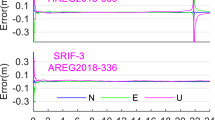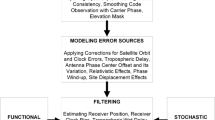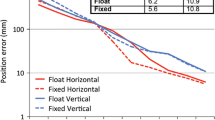Abstract
This work demonstrates that precise point positioning (PPP) can be used not only for positioning, but for a variety of other tasks, such as signal analysis. The fact that the observation model used for accurate error modeling has to take into consideration the several effects present in GPS signals, and that observations are undifferenced, makes PPP a powerful data analysis tool sensitive to a variety of parameters. The PPP application developed at the University of New Brunswick, which is called GAPS (GPS Analysis and Positioning Software), has been designed and built in order to take advantage of available precise products, resulting in a data analysis tool for determining parameters in addition to position, receiver clock error, and neutral atmosphere delay. These other estimated parameters include ionospheric delays, code biases, satellite clock errors, and code multipath among others. In all cases, the procedures were developed in order to be suitable for real-time as well as post-processing applications. One of the main accomplishments in the development described here is the use of very precise satellite products, coupled with a very complete observation error modeling to make possible a variety of analyses based on GPS data. In this paper, several procedures are described, their innovative aspects are pointed out, and their results are analyzed and compared with other sources. The procedures and software are readily adaptable for using data from other global navigation satellite systems.






















Similar content being viewed by others
References
Estey LH, Meertens CM (1999) TEQC: The multi-purpose toolkit for GPS/GLONASS data. GPS Solutions 3(1):42–49. doi:10.1007/PL00012778
Gao Y, Chen K (2004) Performance analysis of precise point positioning using real-time orbit and clock products. J Global Position Syst 3(1–2):95–100
Kouba J (2003) A guide to using International GPS Service (IGS) products [online]. IGS Central Bureau February 2003 Avail at http://igscb.jpl.nasa.gov/igscb/resource/pubs/GuidetoUsingIGSProducts.pdf
Langley RB (2006) E-mail communication–IGSMAIL-5406: UNB1 decommissioned; UNBJ established [online]. Retrieved 10 September 2006 from IGSMAIL, http://igscb.jpl.nasa.gov/mail/igsmail/2006/msg00129.html
Leandro RF, Santos MC (2006) Wide area based precise point positioning. Proceedings of ION GNSS 2006, 26–29 September 2006. Fort Worth, Texas, pp 2272–2278
Leandro RF, Santos MC (2007) An empirical stochastic model for GPS. Proceedings of the Joint Assembly of IAG, lAPSO, IABO, 22–26 August 2005 Cairns, Australia. Int Assoc Geodesy Symp 130:179–185. doi:10.1007/978-3-540-49350-1_28
Leandro RF, Langley RB, Santos MC (2007a) Estimation of P2–C2 biases by means of precise point positioning. Proceedings of ION AM 2007, 23–25 April 2007. Cambridge, Massachusetts, pp 225–231
Leandro RF, Santos MC, Langley RB (2007b) PPP-based ionospheric activity monitoring. Proceedings of ION GNSS 2007, 25–28 September 2007. Fort Worth, Texas, pp 2849–2853
Leandro RF, Langley RB, Santos MC (2008a) UNB3m_pack: a neutral atmosphere delay package for radiometric space techniques. GPS Solut 12(1):65–70. doi:10.1007/s10291-007-0077-5
Leandro RF, Thirumurthi T, Sukeova L, Langley RB, Santos MC (2008b) Analysis of L2C signal quality and its impact on PPP performance. Proceedings of The Institute of Navigation National Technical Meeting, 28–30 January 2008. San Diego, California, pp 1020–1031
Niell AE (1996) Global mapping functions for the atmosphere delay at radio wavelengths. J Geophys Res 101(B2):3227–3246. doi:10.1029/95JB03048
Tétreault P, Kouba J, Héroux P, Legree P (2005) CSRS-PPP: an internet service for GPS user access to the Canadian Spatial Reference Frame. Geomatica 59(1):17–28
Zumberge JF, Heflin MB, Jefferson DC, Watkins MM, Webb FH (1997) Precise point positioning for the efficient and robust analysis of GPS data from large networks. J Geophys Res 102(B3):5005–5018. doi:10.1029/96JB03860
Acknowledgments
The research reported in this paper has been carried out, in part, under the auspices of the Geomatics for Informed Decisions (GEOIDE) Network of Centres of Excellence project “Next-generation Algorithms for Navigation, Geodesy and Earth Sciences Under Modernized Global Navigation Satellite Systems (GNSS).” Support was also provided by the Natural Sciences and Engineering Research Council of Canada. We thank Landon Urquhart for some of the data analysis performed for this paper. We also thank two anonymous reviewers for their helpful advice on improving an earlier version the paper.
Author information
Authors and Affiliations
Corresponding author
Rights and permissions
About this article
Cite this article
Leandro, R.F., Santos, M.C. & Langley, R.B. Analyzing GNSS data in precise point positioning software. GPS Solut 15, 1–13 (2011). https://doi.org/10.1007/s10291-010-0173-9
Received:
Accepted:
Published:
Issue Date:
DOI: https://doi.org/10.1007/s10291-010-0173-9




